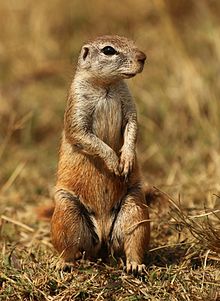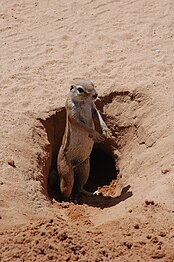Cape ground squirrel
| Cape ground squirrel | |
|---|---|

| |
| At Krugersdorp Game Reserve, South Africa | |
| Scientific classification | |
| Domain: | Eukaryota |
| Kingdom: | Animalia |
| Phylum: | Chordata |
| Class: | Mammalia |
| Order: | Rodentia |
| Family: | Sciuridae |
| Genus: | Geosciurus |
| Species: | G. inauris
|
| Binomial name | |
| Geosciurus inauris (Zimmerman, 1780)
| |

| |
| Cape ground squirrel range | |
| Synonyms | |
|
Xerus inauris | |
The Cape ground squirrel or South African ground squirrel[1][2] (Geosciurus inauris)[3] is found in most of the drier parts of southern Africa from South Africa, through to Botswana, and into Namibia, including Etosha National Park.
The name Cape ground squirrel is somewhat misleading as it actually has a much wider area of habitation. This common name may have been arrived at to distinguish it from a
The species has also been known as the fan-tailed squirrel.
Description
The Cape ground squirrel has black skin with a coat made of short stiff hairs without underfur. The fur is cinnamon on the back while the face, underbelly, sides of neck and ventral sides of limbs are white.[5] The sides of its body each have a white stripe that stretches from the shoulders to the thighs. The eyes are fairly large and have white lines around them. The pinnae are small. The tail is flattened on the back and underside and is covered with white hair and two black bands at the base.[6] The Cape ground's sexual dimorphism is subtle. Males usually weigh 423–649 grams (0.933–1.431 lb), 8 to 12 percent more than females at 444–600 grams (0.979–1.323 lb).[7] Male Cape ground squirrels have a total length of 424–476 millimetres (16.7–18.7 in), while females are 435–446 millimetres (17.1–17.6 in) long.[5] The dental formula of the ground squirrel is 1.1.0.01.1.3.3.[8] The belly and groin area of the females each have two pairs of mammary glands. The glans penis of the males are large with a prominent baculum.[5] This species is notable for its impressively large testicles, which are roughly golf ball size, around 20% of the length of the head and body.[8] Moulting occurs between August and September and between March and April, once per year.[9]
Distribution
The Cape ground squirrel is widespread in southern Africa; through Botswana, South Africa, Lesotho, and Namibia.[1][10] Its range covers most of Namibia but is absent from coastal regions and the northwest.[6] Ground squirrels inhabit central and southwestern Kalahari in Botswana.[11] In South Africa, it can be found in central and north-central areas.[6]
Behaviour and ecology
Cape ground squirrels live mainly in arid or semiarid areas.[9] They prefer to live in veld and grasslands with hard ground. They can also be found in scrub along pans, on floodplains and in agricultural areas.[11] Ground squirrel are generally active during the day and do not hibernate. They are burrowing animals that dig and live in clusters of burrows averaging around 700 square metres (7,500 sq ft)[12] with 2-100 entrances.[9] Burrows serve to protect the squirrel from extreme temperatures at the surface as well as predators. Nevertheless, most of the day is spent feeding at the surface.[10] Squirrels shade their head and back with their bushy tails, which was originally thought to be important for thermoregulation. However, research has revealed that tail raising does not actually decrease core body temperature and seems to mostly serve as a way for squirrels to cool the skin and increase their thermal comfort as they forage in the hot sun in between visits to their burrows.[13] Burrowing has been shown to reduce the squirrel's core body temperature by a few degrees Celsius.[13] Squirrels tend to leave the burrows earlier in the morning in the summer months to avoid the heat, and in the winter months their core body temperature increases rapidly upon exiting their burrows.[14] Dust bathing is also done.
Ground squirrels eat bulbs, fruits, grasses, herbs, insects and shrubs.[5] They forage daily and do not hoard food,.[9] The Cape ground squirrel usually does not need to drink as it gets sufficient moisture from its food.[5] A ground squirrel's daily activities are made of around 70% feeding, 15-20% being vigilant and around 10% socializing.[9][12] The squirrels use the position of the sun as an orientation marker to hide and recover their food.[15]
The burrows of Cape ground squirrels are also used by meerkats and yellow mongooses.[16] While Cape ground squirrels and meerkats appear to have a mutual relationship, mongoose and squirrel relations appear to be more commensal.[16] Predators of ground squirrels include jackals, snakes and monitor lizards. Ground squirrels may be able to scent the differences in the dropping of predators and non-predators.[17] When threatened by predators ground squirrels engage in mobbing behaviour:[16][18] several squirrels rush at the predator while using their bushy tails to block it. When the predator strikes back, all the squirrels back off. However, multiple mobbings are usually successful in driving away predators.[18]
Social behaviour

Cape ground squirrels live in groups of two to three adult females and a maximum of nine sub-adults of either sex
Communication
When perceiving something as a threat, ground squirrels will emit a whistle-like call as an alarm call.[8][10] The alarm call comes in two forms; the short and shrill "bi-jo" which signals serious danger, and a medium-pitched "bi-joo" sound which is used for lesser dangers.[8] During antagonistic encounters, squirrels emit deep growls as signs of aggression.[10] Juvenile squirrels make play calls, nest-chirpings, and protest squeaks.[5]
Reproduction
Cape ground squirrel mate and reproduce year-round
Status
The Cape ground squirrels populations does not seem to be threatened overall. In some areas, it is persecuted as an agricultural pest.[1] In addition, humans have used poisonous grass to control ground squirrel due to crop damage and rabies.[8] It inhabits protected areas, such as Kgalagadi Transfrontier Park in Botswana and South Africa and Etosha National Park in Namibia.[1]
Gallery
-
Young Cape ground squirrels
-
Ground squirrel at burrow entrance
-
Cape ground squirrels
-
Male eating, Tswalu Kalahari Reserve, South Africa
References
- ^ a b c d e Cassola, F. (2017) [errata version of 2016 assessment]. "Xerus inauris". IUCN Red List of Threatened Species. 2016: e.T23145A115167437. Retrieved 19 February 2020.
- OCLC 62265494.
- ^ "Explore the Database". www.mammaldiversity.org. Retrieved 17 August 2021.
- Foljambe, Alice Etheldreda Georgiana Mary (June 1903). – via Wikisource.
- ^ a b c d e f g h i j Skurski, D., J. Waterman. 2005. "Xerus inauris", Mammalian Species 781:1-4.
- ^ a b c Skinner J. D., R. H. N. Smithers. 1990. The mammals of southern African subregion, University of Pretoria.
- ^ Lynch C. D. 1983. "The mammals of the Orange Free State", Memoirs van die Nasionale Museum 18:58-60.
- ^ a b c d e f Zumpt I. F. 1970. "The ground squirrel", African Wild Life 24:115-121.
- ^ a b c d e f g h i j Herzig-Straschil, Barbara (1977). "On the biology of Xerus inauris (Zimmermann, 1780) (Rodentia, Sciuridae)". Zeitschrift für Säugetierkunde. 43: 262–278.
- ^ a b c d e Herzig-Straschil B. 1979. "Xerus inauris (Rodentia, sciuridae)-an inhabitant of arid regions of southern Africa", Folia Zoologica 28:119-124.
- ^ a b c Smithers R. H. N. 1971. The mammals of Botswana, Salisbury, Rhodesia, Museum Memoirs No. 4.
- ^ a b c d e f g h Waterman, J. M. 1995. "The social organization of the Cape ground squirrel (Xerus inauris; Rodentia: Sciuridae)". Ethology 101:130–147.
- ^ PMID 19041951.
- PMID 22558324.
- PMID 27580797.
- ^ a b c Waterman, J., J. Roth. 2007. "Interspecific associations of Cape ground squirrels with two mongoose species: benefit or cost?". Behavioral Ecology and Sociobiology, 61(11):1675-1683.
- ^ Belton, L., N. Ball, J. Waterman, P. Bateman. 2007. "Do Cape ground squirrels (Xerus inauris) discriminate between olfactory cues in the faeces of predators versus non-predators?", African Zoology, 42(1): 135-138.
- ^ a b Waterman, J. M. 1997. "Why do male Cape ground squirrels live in groups?" Animal Behaviour 53:809–817.
- .
- ^ S2CID 38692812.
- ^ JSTOR 1382715.
- PMID 20927404.
External links
 Media related to Xerus inauris at Wikimedia Commons
Media related to Xerus inauris at Wikimedia Commons





